Alexander Cup final played at the Adelaide pub, Teddington on 14 April 2023

Where on earth to begin? Probably at the beginning. This was Battersea’s return to the Alexander Cup – and indeed to Surrey chess generally – after a long absence. They had beaten a very strong Epsom team in the semi-final and frankly we feared them. We were strong, but we knew that on paper they were likely to be even stronger. And so it proved: GM Simon Williams on board 1, IMs Gavin Wall and Chris Baker on 2 and 3, a 2230-rated player on board 7, an average ratings plus across the teams of about 50 points. This was going to be some challenge.
But one thing the Kingston team has going for it, as well as great individual talent, is collective esprit de corps, under Ljubica Lazarevic’s inspired captaincy. This was not a team that was going to lie down, no matter what the rating difference was and how many titled players our opponents had. Kingston’s first team had not been beaten since competitive chess resumed after the pandemic, and it was not going to relinquish that proud boast lightly. But where were our points going to come from?
On board 6, Will Taylor turned down an early draw offer from Battersea captain Blair Connell, despite a ratings disadvantage of more than 100 points. “With a tactical draw offer, since Blair was Black and Battersea outrated us on most boards, I did wonder whether it was still advantageous from a match perspective for me to accept, being heavily outrated myself,” Will explained later, “but it felt too negative at such an early stage.” Lazarevic had asked her players to be wary of accepting “grandmasterly” draws – every point was going to be precious – and it made sense to keep the Battersea skipper immersed in his own game for as long as possible. The virtues of the non-playing captain.
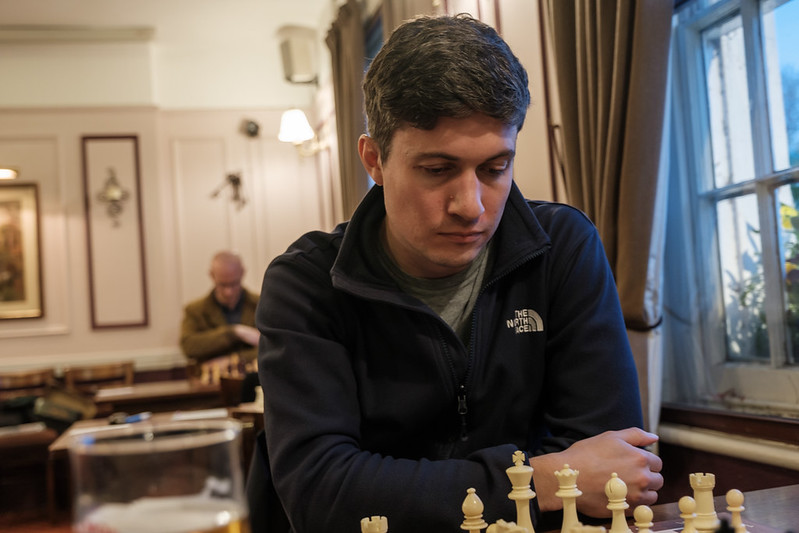
On board 5, Battersea junior Luca Buanne was playing well against Kingston’s Vladimir Li, whose Surrey rating of 2196 does not reflect his true strength (elo 2294 and rising!). This was a game where we had hoped to take the full point, but Buanne played quickly and confidently against Vladimir’s Sicilian, had no difficulty equalising, and a draw was agreed after 22 moves. Not exactly grandmasterly, but Vladimir is very close to getting an FM title and on this showing Buanne – one of the strongest 15-year-olds in the country – will be following him to a title very soon.
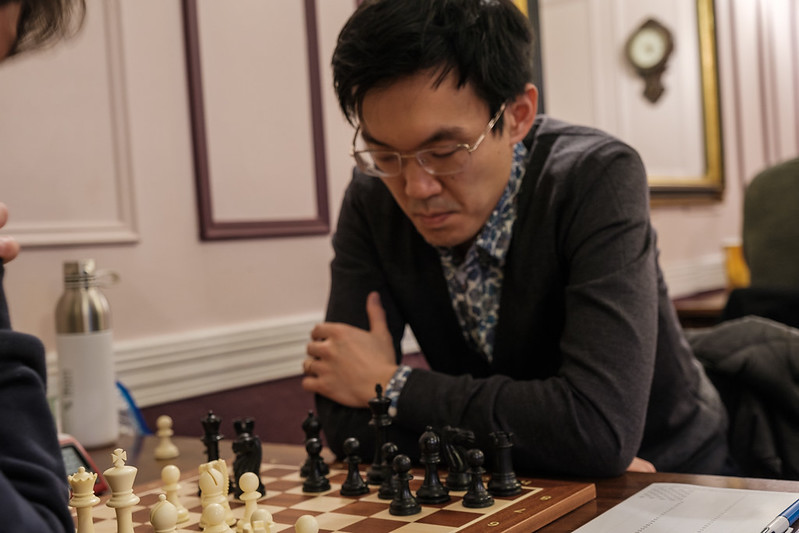
Board 10 was the only match-up where we had a clear rating advantage, so we were – while trying not to exert unnecessary extra pressure – relying on Peter Andrews to bring home the bacon. He did not disappoint, playing his favoured English (cue bacon puns) and out-techniquing his opponent Greg Taylor. Taylor built up a big time plus and may have assumed that trying to create tactical complexities, rather than grabbing back a pawn when he had an opportunity, would work to his advantage. Happily for us, it didn’t.
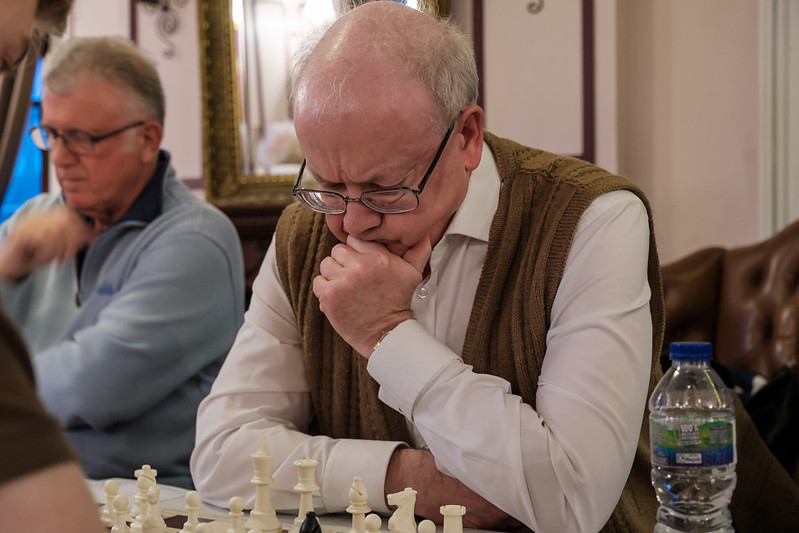
In the position below, Peter thought his opponent might have been playing for 28…Qxc5, missing the fact that when he captured the white queen with his rook a back-rank mate would follow. Two pawns down and with White’s rook established on the seventh, this position is hopeless for Black (at least -6, according to engines). The game is already resignable, but became irretrievable when Black dropped the rook on a6, having forgotten there was no longer a pawn on b7 to protect it from the white queen. A victory for cumulative pressure.
Almost at the same moment that Peter Andrews was securing Kingston’s first point, our other Peter – the incomparable Lalić – was agreeing a draw with IM Gavin Wall on board 2. Peter L, with typical verve, had played the Staunton Gambit against Gavin’s Dutch Defence (1. d4 f5 2. Nc3 Nf6 3. e4 fxe4 4. Bg5 Nc6 5. d5 Ne5 6. Qe2 c6 7. O-O-O Nxd5 8. Nxd5 Nf7 9. Bh4 cxd5 10. Rxd5 b6). He stood better in the middle game, but was running short of time and allowed a draw by repetition.
“Gavin played his first 10 moves instantly,” Peter explained later. “He told me afterwards that he had played the identical opening the day before, against Graham Keane in the London League. By contrast, I hadn’t tried the Staunton Gambit in at least a decade. Hence my trepidation.”
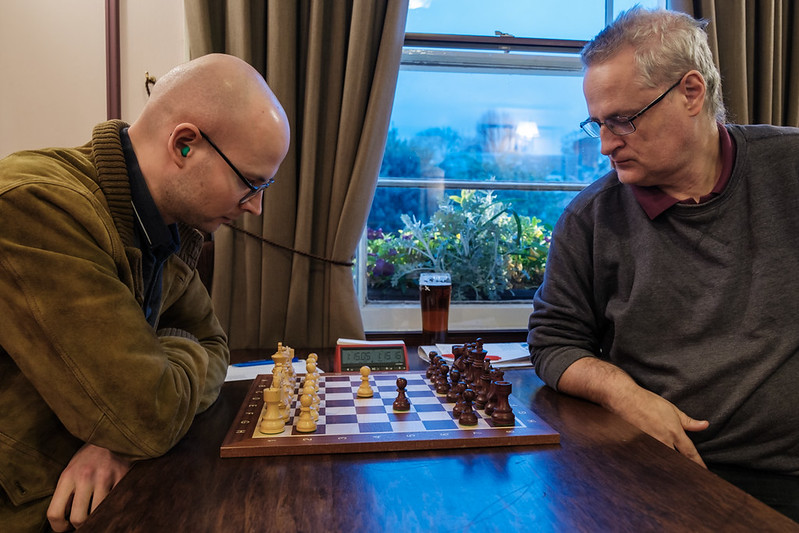
Kingston were 2-1 up, but in a 10-board match that meant little, especially with Alan Scrimgour apparently in trouble on board 9 and David Maycock, with Black, facing a GM on board 1.
In the next game to finish, Blair Connell (who had declared his intentions by playing the Fort Knox variation of the French) finally got his draw against Will Taylor. This was the position in which peace was declared:
Will was down on the clock and felt he no longer had realistic winning chances, so took the draw. A good result given the rating difference, allowing us to keep our noses in front. But the result that really made us believe we might win came next, with Mike Healey beating the highly rated Viktor Stoyanov on board 4. This was a tremendous game by Mike, paving the way for everything that came later.
Stoyanov played the Caro-Kann and Mike opted for the so-called Fantasy Variation (1. e4 c6 2. d4 d5 3. f3). The first 20 moves, with both players committing to the fight, were very even, and on move 24 (shortly after Mike had spurned a draw offer) this position was reached:
Here Mike, who much prefers eccentric knights to rather predictable rooks, made a very Mike decision: 24. Rdxd5! “White temporarily gives up an exchange,” he explained later, “but something is dropping for Black.” The game proceeded 24…cxd5 25. Rxd5 Re1+ 26. Kd2 Rae8 27. Rxc5. R8e2+ 28. Kd3 Re3+ 29. Kd4 R3e2 30. Bd3 Re8 31. Nf4 Rd1 32. Rd5 Bc8 33. Kc5 Rde1 34. Bxb5 R8e5 35. Bc4 Rxd5+ 36. Bxd5+ Kf8
Mike’s faith in his knights has paid off – his position is completely winning: 37. Ng6+ Ke8 38. Kd6 Rd1 39. c4 Bb7 40. Ne6 Bxd5 41. Nc7+ Kd8 42.Nxd5 Rd2 43.c5 Rxb2 44.c6 Rd2 45. Ne7 1-0 A very good knight – or indeed knights. That made it 3.5-1.5 and the early pessimism of Kingston supporters was starting to dissipate. We really could win this.
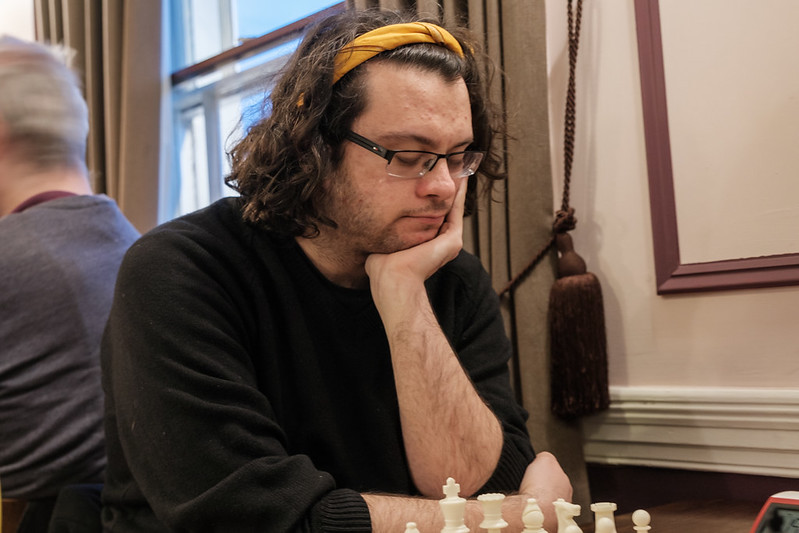
On board 7, Kingston’s David Rowson more than held his own with Black against Chris Beckett, who outrated him by almost 200 points. “It wasn’t the most exciting of games, but I was pleased to get a draw from a strong player,” David said later. “For once my Old Indian Defence led to Black, not White, getting the upper hand on the queenside, as my opponent made a couple of inaccuracies. I resisted the temptation to draw by repetition on move 26, but I didn’t have enough of an advantage to make anything of the ending.” This was the position in which a draw was agreed. Engines evaluate it as completely level.

John Foley’s game against Duncan Kerr on board 8 was another canny, nip-and-tuck affair between two very experienced players, with threats and counter-threats from an early stage. In the final position, John’s passed d-pawn looks as if it might have potential, which was enough for Black to offer the draw. John could have continued with 36. Qxa6 but after the queens are exchanged the endgame is drawish.
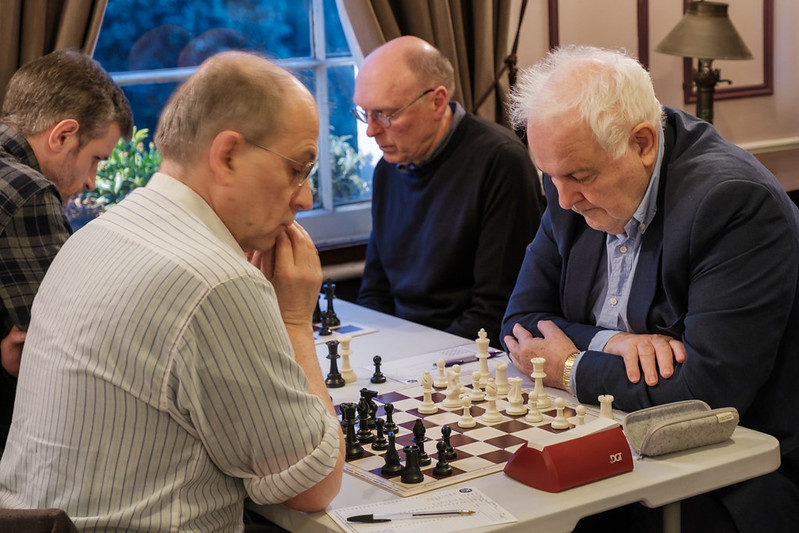
The score was now 4.5-2.5 in Kingston’s favour and the winning line was in sight. Or was it? David Maycock was losing on board 1, Alan Scrimgour was losing on board 9, and the final game – Silverio Abasolo, with Black, up against IM Chris Baker on board 3 – was far from clear. The most likely scenario, pundits agreed (and Kingston pessimists feared), was a 5-5 draw, with Battersea winning on board count by virtue of victory on board 1.
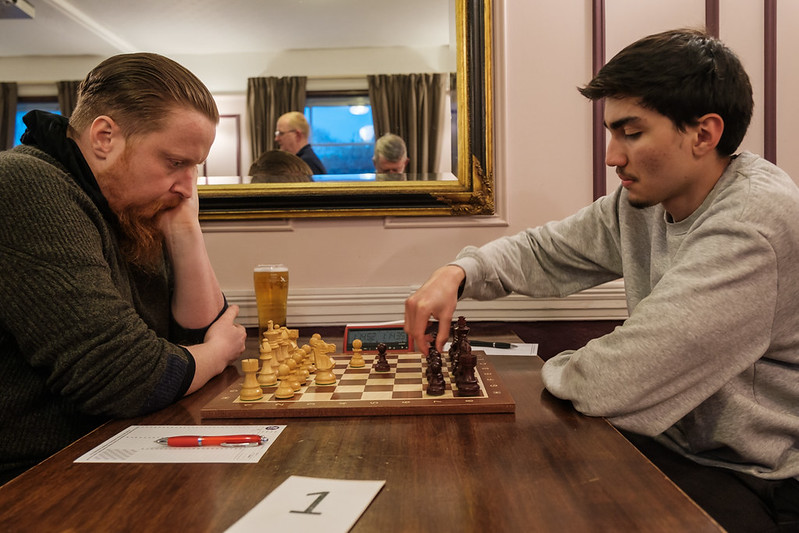
David Maycock competed fiercely against Simon Williams on top board, but started to run short of time in the latter stages of the game. GMs are of course superfast calculators, and Williams set David many problems. “I solved a million of them, but couldn’t solve the million and one-th,” David said afterwards. Black is doing OK in this position, but the rook on c8 is under attack. Would should David play?
Best is probably Rxc1, with good drawing chances. But David opted for 27…Rc5, which loses to a forced sequence: 28. Bxe4 dxe4 29. Rxc5 bxc5 30. Nc6+ Qxc6 31. Qxh8+ Ka7 32. Qb2 Qb5 33. Rb1 Qc6 34. Qb6+ Qxb6 35. Rxb6 1-0. That made it 4.5-3.5, and it was getting too close for comfort.
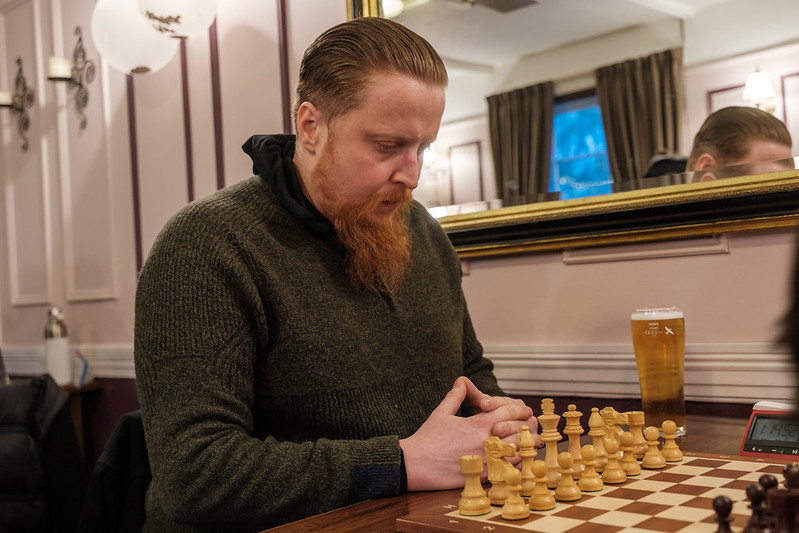
A few minutes later the scores were tied as Battersea’s Robert Noyce won against Kingston chair Alan Scrimgour. Alan was candid later about a game – a Closed Sicilian – which he felt had started to unravel at quite an early stage. “My first mistake was to close the centre with d4,” he explained. “I should have exchanged on e4 to keep some open lines. I then made a bad strategic decision to castle queenside. The result was that I had no counterplay and had to defend. My opponent took no chances and carefully built up his attack. In a difficult position I made further inaccuracies and my opponent finished clinically.”

The match was all square, so now – in the scenario which had been bothering us for the past hour – Kingston’s Silverio Abasolo had to win on board 3 against IM Chris Baker or we would lose the match on board count. No pressure. Silverio, though, a very strong player with a Fide rating of 2283 who has only resumed playing serious competitive chess this season after an eight-year break, is a cool customer who plays quickly and fluently . At no stage did he show any signs of tension and he continued recording even in a time scramble, where he was playing moves on the 10-second increment (all the games on the night were played at a time control of 75 minutes + 10 seconds per move).

Baker had played another English Opening – it was a big night for the English – but Silverio skilfully established a small plus and, with Black to play on move 21 in the position below, he made a key strategic decision:
From many competing possible moves with very similar evaluations (this is actually the computer’s seventh choice), Silverio chose to swap bishop for knight. That choice largely determined the course of the rest of the game. Silverio’s knight found good squares, and on move 31, though objectively White now had an edge, he played a bold move which John Saunders, who will be annotating the game for the Kingston website, said caused a “psychological swing” by turning the screw on Baker.
Here Silverio plays 31…Qc5, threatening both the pawn on f2 and, more pressingly for White, a back-rank mate. White should play Qb2, which would maintain his edge, but instead he chose Rg1, presumably to counterattack down the g-file if Black played Qxf2, but overlooking 32. Nh3, which led to White giving up the exchange.
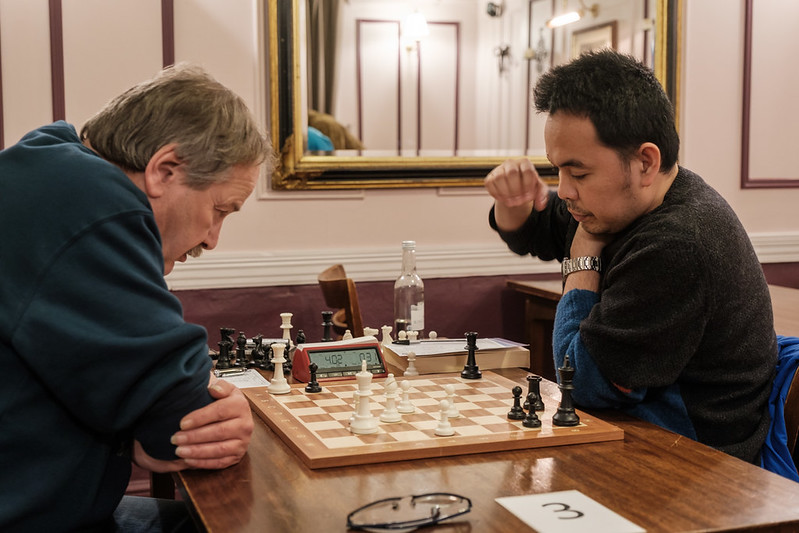
Even after going the exchange up, however, there were still complications. Silverio missed an immediately winning continuation, and Baker tried to menace Black’s king with his queen and bishop. Even when Silverio had queened his a-pawn, Baker would not call it a day and was threatening mate in one. Saunders took a final photograph as Silverio, with 30 seconds left on his clock, countered the mate threat with a check of his own and proceeded to calmly notate the move.
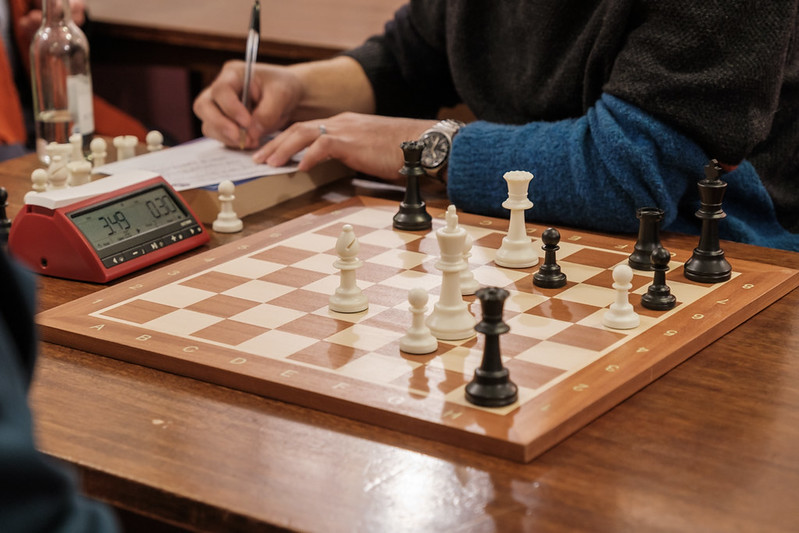
Now it really was all over bar the whooping – and the applause for Silverio. The two queens did their work and White was mated. Kingston had won a magnificent victory against the odds and the Alexander Cup could stay in our trophy cabinet for another year, alongside the trophies for winning both the Surrey League and the Thames Valley League this season. If we win the Thames Valley Knockout against Harrow on 22 May we will have chalked up a unique “Quadruple”. If we do, what on earth will we do next? Collapse probably.
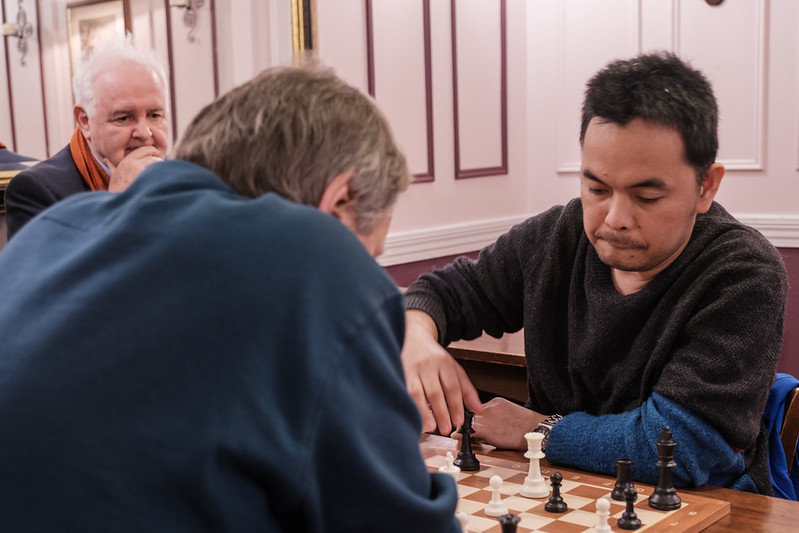
We should put on record our thanks to Battersea for a memorable match played in a good spirit, to John Saunders for taking a wonderful set of photographs and for putting all the game scores on his superb BritBase site, to Richmond Chess Club for hosting the final (the Surrey association specifies it must be played at a neutral venue and the Adelaide pub in Teddington is perfect), and to tournament controller Huw Williams for acting as arbiter with just the right balance of firmness and discretion – visible but never overbearing. It was truly an epic match.
Battersea captain Blair Connell said afterwards that he doubted whether he would ever recover, but our fear is that next year they will be back with even more of their celebrity GMs. Thus does the bar get raised with every succeeding season. And talking of the bar…
Stephen Moss

